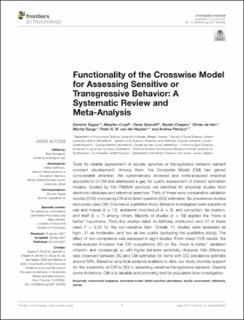| dc.contributor.author | Sagoe, Dominic | |
| dc.contributor.author | Cruyff, Maarten | |
| dc.contributor.author | Spendiff, Owen | |
| dc.contributor.author | Chegeni, Razieh | |
| dc.contributor.author | de Hon, Olivier | |
| dc.contributor.author | Saugy, Martial | |
| dc.contributor.author | van der Heijden, Peter G. M. | |
| dc.contributor.author | Petróczi, Andrea | |
| dc.date.accessioned | 2021-08-13T09:02:25Z | |
| dc.date.available | 2021-08-13T09:02:25Z | |
| dc.date.created | 2021-06-27T13:14:39Z | |
| dc.date.issued | 2021 | |
| dc.identifier.issn | 1664-1078 | |
| dc.identifier.uri | https://hdl.handle.net/11250/2767734 | |
| dc.description.abstract | Tools for reliable assessment of socially sensitive or transgressive behavior warrant constant development. Among them, the Crosswise Model (CM) has gained considerable attention. We systematically reviewed and meta-analyzed empirical applications of CM and addressed a gap for quality assessment of indirect estimation models. Guided by the PRISMA protocol, we identified 45 empirical studies from electronic database and reference searches. Thirty of these were comparative validation studies (CVS) comparing CM and direct question (DQ) estimates. Six prevalence studies exclusively used CM. One was a qualitative study. Behavior investigated were substance use and misuse (k = 13), academic misconduct (k = 8), and corruption, tax evasion, and theft (k = 7) among others. Majority of studies (k = 39) applied the “more is better” hypothesis. Thirty-five studies relied on birthday distribution and 22 of these used P = 0.25 for the non-sensitive item. Overall, 11 studies were assessed as high-, 31 as moderate-, and two as low quality (excluding the qualitative study). The effect of non-compliance was assessed in eight studies. From mixed CVS results, the meta-analysis indicates that CM outperforms DQ on the “more is better” validation criterion, and increasingly so with higher behavior sensitivity. However, little difference was observed between DQ and CM estimates for items with DQ prevalence estimate around 50%. Based on empirical evidence available to date, our study provides support for the superiority of CM to DQ in assessing sensitive/transgressive behavior. Despite some limitations, CM is a valuable and promising tool for population level investigation. | en_US |
| dc.language.iso | eng | en_US |
| dc.publisher | Frontiers Media | en_US |
| dc.rights | Navngivelse 4.0 Internasjonal | * |
| dc.rights.uri | http://creativecommons.org/licenses/by/4.0/deed.no | * |
| dc.title | Functionality of the Crosswise Model for Assessing Sensitive or Transgressive Behavior: A Systematic Review and Meta-Analysis | en_US |
| dc.type | Journal article | en_US |
| dc.type | Peer reviewed | en_US |
| dc.description.version | publishedVersion | en_US |
| dc.rights.holder | Copyright 2021 Sagoe, Cruyff, Spendiff, Chegeni, de Hon, Saugy, van der Heijden and Petróczi | en_US |
| dc.source.articlenumber | 655592 | en_US |
| cristin.ispublished | true | |
| cristin.fulltext | original | |
| cristin.qualitycode | 1 | |
| dc.identifier.doi | 10.3389/fpsyg.2021.655592 | |
| dc.identifier.cristin | 1918727 | |
| dc.source.journal | Frontiers in Psychology | en_US |
| dc.identifier.citation | Frontiers in Psychology. 2021, 12, 655592. | en_US |
| dc.source.volume | 12 | en_US |

